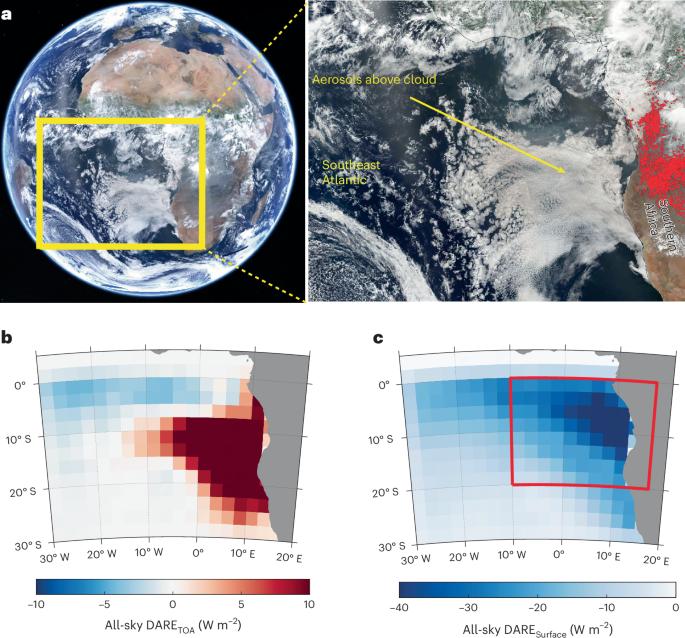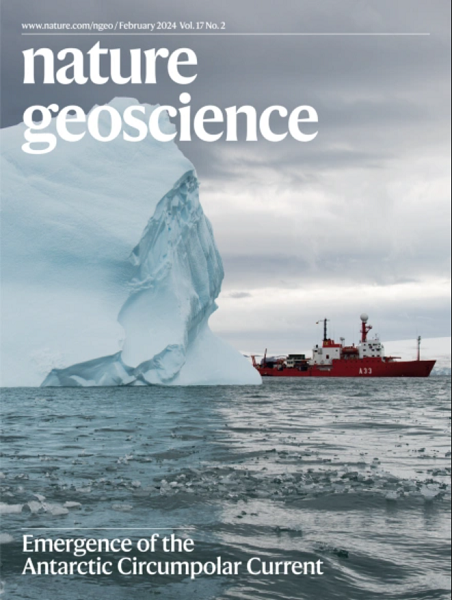低云日循环增强了区域气溶胶增温
IF 16.1
1区 地球科学
Q1 GEOSCIENCES, MULTIDISCIPLINARY
引用次数: 0
摘要
大气气溶胶是地球气候系统的一个重要组成部分,对未来气候变化的预测造成很大的不确定性。在大西洋东南部,膨胀的吸光烟雾气溶胶羽流覆盖在半永久性层积云之上,直接气溶胶辐射效应(DARE)引起变暖,但这种效应的大小在气候模式之间差异很大。因此,有必要改进基于观测的估计,以帮助约束模型的不确定性。然而,观测到的云日循环对DARE的影响尚不清楚。在这里,我们使用辐射传输模型来量化DARE,该模型基于集中在20°S-0°和10°W-15°E区域的云的每小时卫星观测。我们发现,考虑到东南大西洋上空观测到的云日循环,而不是假设全天都有一个恒定的午后云场,导致区域平均气溶胶辐射变暖增加了两倍以上(+1.7±0.4 W m−2)。DARE的增加是由于清晨时云分和光学深度较高。忽视云的日循环增加了与气候模式中低估气溶胶吸收有关的东南大西洋辐射变暖的低估。未来基于观测的气溶胶气候效应估计需要考虑云的日循环。本文章由计算机程序翻译,如有差异,请以英文原文为准。


Regional aerosol warming enhanced by the diurnal cycle of low cloud
Atmospheric aerosols are an important component of the Earth’s climate system and contribute substantial uncertainties to predictions of future climate change. In the southeast Atlantic, where expansive light-absorbing smoke aerosol plumes overlie semi-permanent stratocumulus clouds, the direct aerosol radiative effect (DARE) induces warming, but the magnitude of this effect varies widely among climate models. Thus, it is essential to improve estimates based on observations to help constrain model uncertainties. However, the impact of the observed cloud diurnal cycle on DARE remains unclear. Here we quantify DARE using radiative transfer modelling based on hourly satellite observations of clouds focusing on the region 20° S–0° and 10° W–15° E. We find that accounting for the observed cloud diurnal cycle over the southeast Atlantic, rather than assuming a constant early-afternoon cloud field throughout the entire day, results in a more than twofold increase (+1.7 ± 0.4 W m−2) in the regional mean aerosol radiative warming. The increase in DARE results from morning hours when cloud fractions and optical depths are higher. Neglect of the cloud diurnal cycle adds to the underestimated radiative warming in the southeast Atlantic associated with underestimated aerosol absorption among climate models. Future observations-based estimates of aerosol climatic effects need to account for the cloud diurnal cycle. Accounting for the diurnal cycle in low clouds more than doubles estimated aerosol radiative warming in the southeast Atlantic, according to radiative transfer modelling and satellite observations.
求助全文
通过发布文献求助,成功后即可免费获取论文全文。
去求助
来源期刊

Nature Geoscience
地学-地球科学综合
CiteScore
26.70
自引率
1.60%
发文量
187
审稿时长
3.3 months
期刊介绍:
Nature Geoscience is a monthly interdisciplinary journal that gathers top-tier research spanning Earth Sciences and related fields.
The journal covers all geoscience disciplines, including fieldwork, modeling, and theoretical studies.
Topics include atmospheric science, biogeochemistry, climate science, geobiology, geochemistry, geoinformatics, remote sensing, geology, geomagnetism, paleomagnetism, geomorphology, geophysics, glaciology, hydrology, limnology, mineralogy, oceanography, paleontology, paleoclimatology, paleoceanography, petrology, planetary science, seismology, space physics, tectonics, and volcanology.
Nature Geoscience upholds its commitment to publishing significant, high-quality Earth Sciences research through fair, rapid, and rigorous peer review, overseen by a team of full-time professional editors.
 求助内容:
求助内容: 应助结果提醒方式:
应助结果提醒方式:


